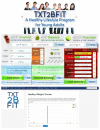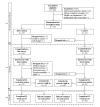Effectiveness of a mHealth Lifestyle Program With Telephone Support (TXT2BFiT) to Prevent Unhealthy Weight Gain in Young Adults: Randomized Controlled Trial
- PMID: 26076688
- PMCID: PMC4526939
- DOI: 10.2196/mhealth.4530
Effectiveness of a mHealth Lifestyle Program With Telephone Support (TXT2BFiT) to Prevent Unhealthy Weight Gain in Young Adults: Randomized Controlled Trial
Abstract
Background: Weight gained in young adulthood often persists throughout later life with associated chronic disease risk. Despite this, current population prevention strategies are not specifically designed for young adults.
Objective: We designed and assessed the efficacy of an mHealth prevention program, TXT2BFiT, in preventing excess weight gain and improving dietary and physical activity behaviors in young adults at increased risk of obesity and unhealthy lifestyle choices.
Methods: A two-arm, parallel-group randomized controlled trial was conducted. Subjects and analyzing researchers were blinded. A total of 250 18- to 35-year-olds with a high risk of weight gain, a body mass index (BMI) of 23.0 to 24.9 kg/m(2) with at least 2 kg of weight gain in the previous 12 months, or a BMI of 25.0 to 31.9 kg/m(2) were randomized to the intervention or control group. In the 12-week intervention period, the intervention group received 8 text messages weekly based on the transtheoretical model of behavior change, 1 email weekly, 5 personalized coaching calls, a diet booklet, and access to resources and mobile phone apps on a website. Control group participants received only 4 text messages and printed dietary and physical activity guidelines. Measured body weight and height were collected at baseline and at 12 weeks. Outcomes were assessed via online surveys at baseline and at 12 weeks, including self-reported weight and dietary and physical activity measures.
Results: A total of 214 participants-110 intervention and 104 control-completed the 12-week intervention period. A total of 10 participants out of 250 (4.0%)-10 intervention and 0 control-dropped out, and 26 participants (10.4%)-5 intervention and 21 control-did not complete postintervention online surveys. Adherence to coaching calls and delivery of text messages was over 90%. At 12 weeks, the intervention group were 2.2 kg (95% CI 0.8-3.6) lighter than controls (P=.005). Intervention participants consumed more vegetables (P=.009), fewer sugary soft drinks (P=.002), and fewer energy-dense takeout meals (P=.001) compared to controls. They also increased their total physical activity by 252.5 MET-minutes (95% CI 1.2-503.8, P=.05) and total physical activity by 1.3 days (95% CI 0.5-2.2, P=.003) compared to controls.
Conclusions: The TXT2BFiT low-intensity intervention was successful in preventing weight gain with modest weight loss and improvement in lifestyle behaviors among overweight young adults. The short-term success of the 12-week intervention period shows potential. Maintenance of the behavior change will be monitored at 9 months.
Trial registration: The Australian New Zealand Clinical Trials Registry ACTRN12612000924853; https://www.anzctr.org.au/Trial/Registration/TrialReview.aspx?ACTRN=12612000924853 (Archived by WebCite at http://www.webcitation.org/6Z6w9LlS9).
Keywords: lifestyle behavior; mHealth; weight gain prevention; young adults.
Conflict of interest statement
Conflicts of Interest: None declared.
Figures
Similar articles
-
A Mobile Health Lifestyle Program for Prevention of Weight Gain in Young Adults (TXT2BFiT): Nine-Month Outcomes of a Randomized Controlled Trial.JMIR Mhealth Uhealth. 2016 Jun 22;4(2):e78. doi: 10.2196/mhealth.5768. JMIR Mhealth Uhealth. 2016. PMID: 27335237 Free PMC article.
-
'TXT2BFiT' a mobile phone-based healthy lifestyle program for preventing unhealthy weight gain in young adults: study protocol for a randomized controlled trial.Trials. 2013 Mar 18;14:75. doi: 10.1186/1745-6215-14-75. Trials. 2013. PMID: 23506013 Free PMC article. Clinical Trial.
-
Process evaluation of TXT2BFiT: a multi-component mHealth randomised controlled trial to prevent weight gain in young adults.Int J Behav Nutr Phys Act. 2016 Jan 19;13:7. doi: 10.1186/s12966-016-0329-2. Int J Behav Nutr Phys Act. 2016. PMID: 26785637 Free PMC article. Clinical Trial.
-
Comparing Two Programs for Weight Loss among Marshallese Adults Living in the United States [Internet].Washington (DC): Patient-Centered Outcomes Research Institute (PCORI); 2022 Mar. Washington (DC): Patient-Centered Outcomes Research Institute (PCORI); 2022 Mar. PMID: 39666844 Free Books & Documents. Review.
-
Can an Online Program Help Women with a History of Preeclampsia Reduce Their Risk of Heart Disease? [Internet].Washington (DC): Patient-Centered Outcomes Research Institute (PCORI); 2020 Jan. Washington (DC): Patient-Centered Outcomes Research Institute (PCORI); 2020 Jan. PMID: 39556671 Free Books & Documents. Review.
Cited by
-
Expanding the Capabilities of Nutrition Research and Health Promotion Through Mobile-Based Applications.Adv Nutr. 2021 Jun 1;12(3):1032-1041. doi: 10.1093/advances/nmab022. Adv Nutr. 2021. PMID: 33734305 Free PMC article.
-
Smartphone-Based Health Program for Improving Physical Activity and Tackling Obesity for Young Adults: A Systematic Review and Meta-Analysis.Int J Environ Res Public Health. 2019 Dec 18;17(1):15. doi: 10.3390/ijerph17010015. Int J Environ Res Public Health. 2019. PMID: 31861359 Free PMC article.
-
Social media use for nutrition outcomes in young adults: a mixed-methods systematic review.Int J Behav Nutr Phys Act. 2018 Jul 24;15(1):70. doi: 10.1186/s12966-018-0696-y. Int J Behav Nutr Phys Act. 2018. PMID: 30041699 Free PMC article.
-
Improved eating behaviours mediate weight gain prevention of young adults: moderation and mediation results of a randomised controlled trial of TXT2BFiT, mHealth program.Int J Behav Nutr Phys Act. 2016 Apr 2;13:44. doi: 10.1186/s12966-016-0368-8. Int J Behav Nutr Phys Act. 2016. PMID: 27039178 Free PMC article. Clinical Trial.
-
Effectiveness of a mHealth intervention on hypertension control in a low-resource rural setting: A randomized clinical trial.Front Public Health. 2023 Mar 1;11:1049396. doi: 10.3389/fpubh.2023.1049396. eCollection 2023. Front Public Health. 2023. PMID: 36935728 Free PMC article. Clinical Trial.
References
-
- Ng M, Fleming T, Robinson M, Thomson B, Graetz N, Margono C, Mullany EC, Biryukov S, Abbafati C, Abera SF, Abraham JP, Abu-Rmeileh NM, Achoki T, AlBuhairan FS, Alemu ZA, Alfonso R, Ali MK, Ali R, Guzman NA, Ammar W, Anwari P, Banerjee A, Barquera S, Basu S, Bennett DA, Bhutta Z, Blore J, Cabral N, Nonato IC, Chang JC, Chowdhury R, Courville KJ, Criqui MH, Cundiff DK, Dabhadkar KC, Dandona L, Davis A, Dayama A, Dharmaratne SD, Ding EL, Durrani AM, Esteghamati A, Farzadfar F, Fay DF, Feigin VL, Flaxman A, Forouzanfar MH, Goto A, Green MA, Gupta R, Hafezi-Nejad N, Hankey GJ, Harewood HC, Havmoeller R, Hay S, Hernandez L, Husseini A, Idrisov BT, Ikeda N, Islami F, Jahangir E, Jassal SK, Jee SH, Jeffreys M, Jonas JB, Kabagambe EK, Khalifa SE, Kengne AP, Khader YS, Khang YH, Kim D, Kimokoti RW, Kinge JM, Kokubo Y, Kosen S, Kwan G, Lai T, Leinsalu M, Li Y, Liang X, Liu S, Logroscino G, Lotufo PA, Lu Y, Ma J, Mainoo NK, Mensah GA, Merriman TR, Mokdad AH, Moschandreas J, Naghavi M, Naheed A, Nand D, Narayan KM, Nelson EL, Neuhouser ML, Nisar MI, Ohkubo T, Oti SO, Pedroza A, Prabhakaran D, Roy N, Sampson U, Seo H, Sepanlou SG, Shibuya K, Shiri R, Shiue I, Singh GM, Singh JA, Skirbekk V, Stapelberg NJ, Sturua L, Sykes BL, Tobias M, Tran BX, Trasande L, Toyoshima H, van de Vijver S, Vasankari TJ, Veerman JL, Velasquez-Melendez G, Vlassov VV, Vollset SE, Vos T, Wang C, Wang X, Weiderpass E, Werdecker A, Wright JL, Yang YC, Yatsuya H, Yoon J, Yoon SJ, Zhao Y, Zhou M, Zhu S, Lopez AD, Murray CJ, Gakidou E. Global, regional, and national prevalence of overweight and obesity in children and adults during 1980-2013: a systematic analysis for the Global Burden of Disease Study 2013. Lancet. 2014 Aug 30;384(9945):766–781. doi: 10.1016/S0140-6736(14)60460-8.S0140-6736(14)60460-8 - DOI - PMC - PubMed
-
- Tanamas SK, Magliano DJ, Lynch B, Sethi P, Willenberg L, Polkinghorne K, Chadban S, Dunstan D, Shaw JE. AusDiab 2012: The Australian Diabetes, Obesity and Lifestyle Study. Melbourne, Australia: Baker IDI Heart and Diabetes Institute; 2013. [2015-06-01]. Chapter 3: Obesity http://www.bakeridi.edu.au/Assets/Files/Baker%20IDI%20Ausdiab%20Report_i... .
-
- Reither EN, Hauser RM, Yang Y. Do birth cohorts matter? Age-period-cohort analyses of the obesity epidemic in the United States. Soc Sci Med. 2009 Nov;69(10):1439–1448. doi: 10.1016/j.socscimed.2009.08.040. http://europepmc.org/abstract/MED/19773107 S0277-9536(09)00575-9 - DOI - PMC - PubMed
-
- Truesdale KP, Stevens J, Lewis CE, Schreiner PJ, Loria CM, Cai J. Changes in risk factors for cardiovascular disease by baseline weight status in young adults who maintain or gain weight over 15 years: the CARDIA study. Int J Obes (Lond) 2006 Sep;30(9):1397–1407. doi: 10.1038/sj.ijo.0803307. http://europepmc.org/abstract/MED/16534519 0803307 - DOI - PMC - PubMed
LinkOut - more resources
Full Text Sources
Other Literature Sources
Miscellaneous



